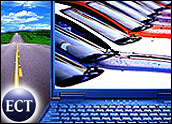
The automotive industry is lagging far behind others in terms of e-business progress, according to a study released Wednesday by consulting firm KPMG.
Brian Ambrose, national industry director of KPMG’s automotive practice, told the E-Commerce Times that both automotive suppliers and original equipment manufacturers (OEMs) have been hesitant to join an e-marketplace that involves competitors sharing information.
In order to move forward, according to KPMG, automakers and their suppliers need to overcome significant cultural, technological and security issues. However, Ambrose said that in time, the automotive industry will become more comfortable with e-business marketplaces.
“A healthy competitive environment in the ranks is a good thing,” Ambrose said.
For the study, KPMG surveyed automotive leaders from multinational OEMs and Tier 1 and Tier 2 suppliers in the United States, England, Germany and Japan.
Inertia Reigns
In the KPMG survey, 51 percent of automotive executives cited cost as a barrier to e-business. Forty-seven percent mentioned the need to re-engineer business processes, and 45 percent cited a lack of e-business skills.
The study also found that the majority of respondents reported “widespread concern” about security, citing it as one of the factors that prohibit OEMs and suppliers from swiftly adopting digital solutions.
“E-business security is a widespread concern that few companies really seem to understand,” Ambrose said. “There is a misperception out there that smaller Internet projects don’t need security protection by the nature of size.”
Ambrose added, “Security is one of the first e-business investments and one of the wisest. No one needs to have proprietary designs stolen or a production line shut down because of network penetration.”
Spread the Wealth
In order to succeed in the e-world, progress must come bottom-up, not top-down, according to KPMG. Chief executive officers must solicit ideas and initiatives from their operating units and then take action to implement and fund ideas as warranted. Successful ideas must, when possible, be leveraged across the organization.
“One of the hallmarks of successful e-business is integration of the value chain,” Ambrose said. “Instead of keeping all your cards close to the vest, share some of what you are holding with your value chain partners.”
Added Ambrose: “It isn’t a zero-sum game where your win is a value chain partner’s loss. It can be a win-win game where the whole value chain shares information and objectives.”
Dead Last
A study undertaken by KPMG and the Economist Intelligence Unit last summer found that the automotive industry ranked last among the seven industries studied — automotive, financial services, chemical, pharmaceutical, electronics, consumer markets, and communications — in terms of e-business progress, which was measured by advances in technology and to what degree senior management was involved in e-business implementation.
At the time of the survey, only 35 percent of automotive senior executives were actively involved in e-business activities. According to KPMG, this figure was “by far the lowest response” of all industries and “quite lower” than the cross-industry average of 58 percent.
However, Ambrose told the E-Commerce Times that since that time, he thinks the automotive industry has made substantial progress in terms of executive involvement.
Waiting and Seeing
For many, Covisint, the B2B e-marketplace formed last year by competitors General Motors, Ford, DaimlerChrysler, Renault and Nissan, is the role model for the e-marketplace and has been touted as an example of how rivals can work together for the common good.
Ambrose said that many in the automotive industry delayed implementing e-business strategies because they were waiting to see how Covisint fared before launching their own e-business initiatives. After receiving required regulatory approval, Covisint went live in September.
“Waiting to see what a competitor does is not a sound strategy in the e-business world, because those who take a leadership position stand to gain the most in terms of strengthening their balance sheets for acquisitions,” Ambrose said. “Leaders will be rewarded and followers forced to merge.”
Ambrose did say that “the good news is that very few industries have the right equation, and e-business momentum in the automotive industry can change fast.”
What the Future Holds
Overall, the future does look bright for automotive e-business. Ambrose believes the industry will begin realizing cost savings and efficiencies within the next 18 months as Covisint gets up to speed and companies implement their own e-procurement chains.
Ambrose stressed that progress “is going to take time because of the required commitment” and because e-marketplaces are very complex technologically. He also believes that Covisint’s progress will accelerate once it finds a CEO.![]()



























































Social Media
See all Social Media